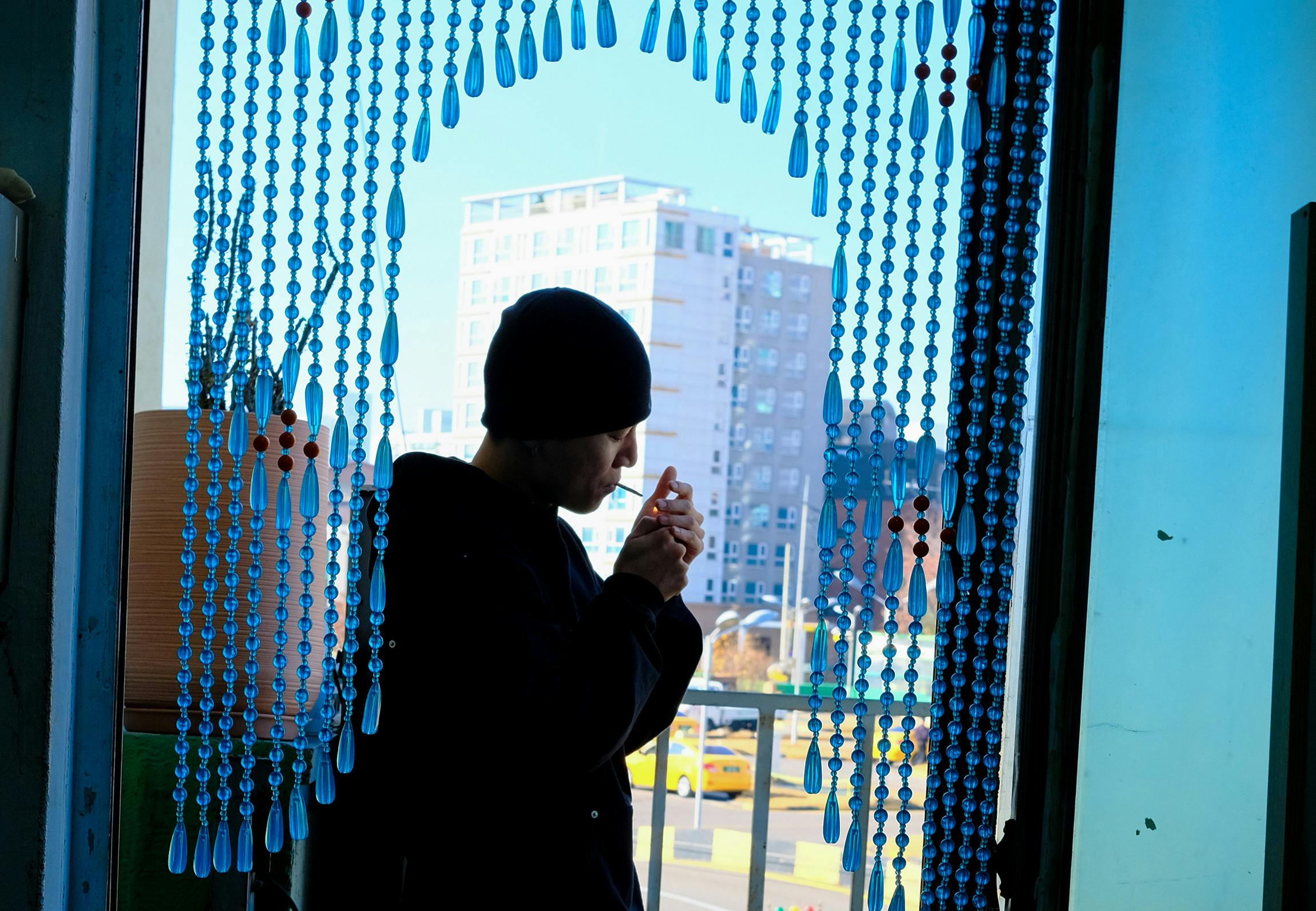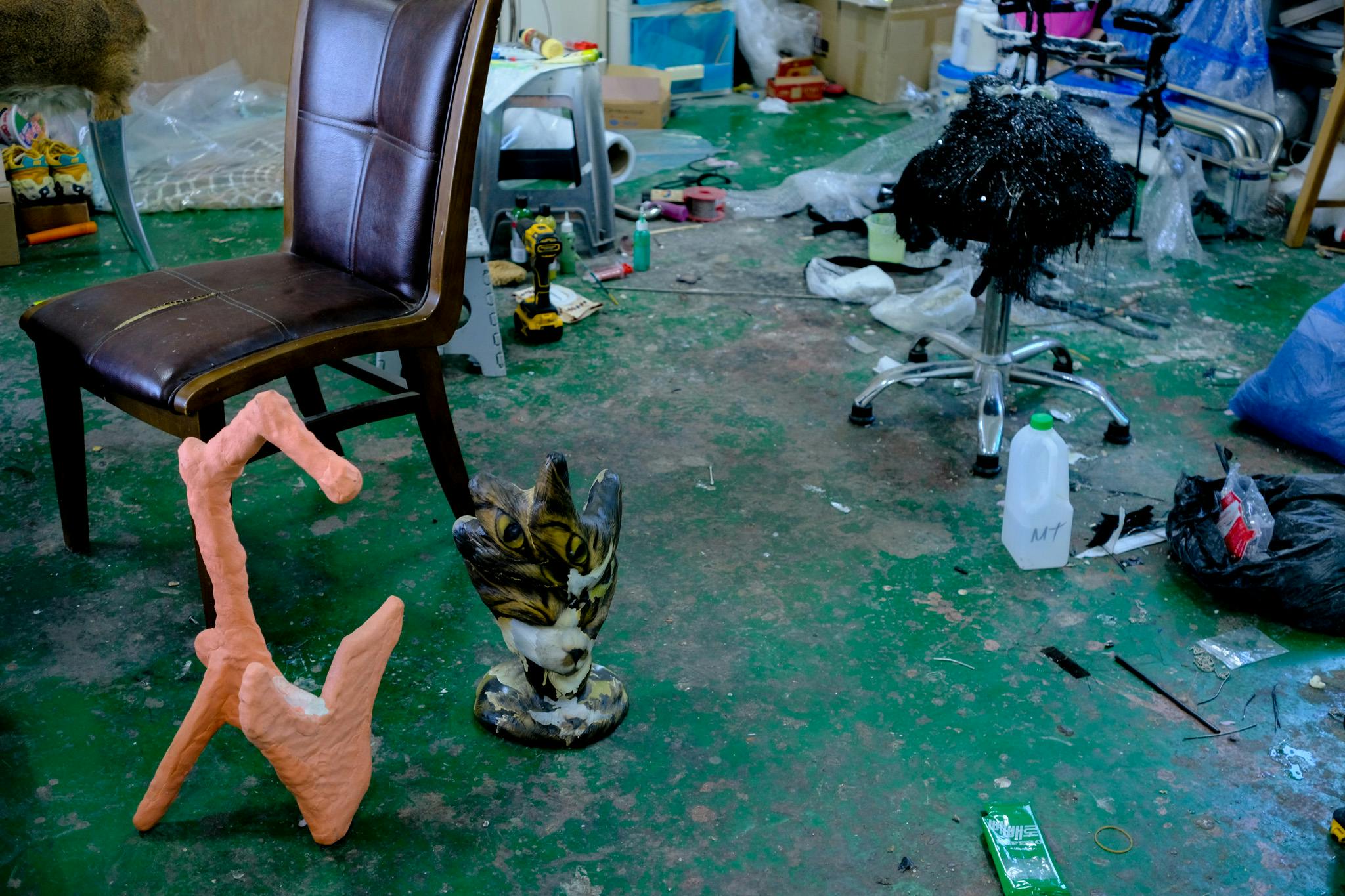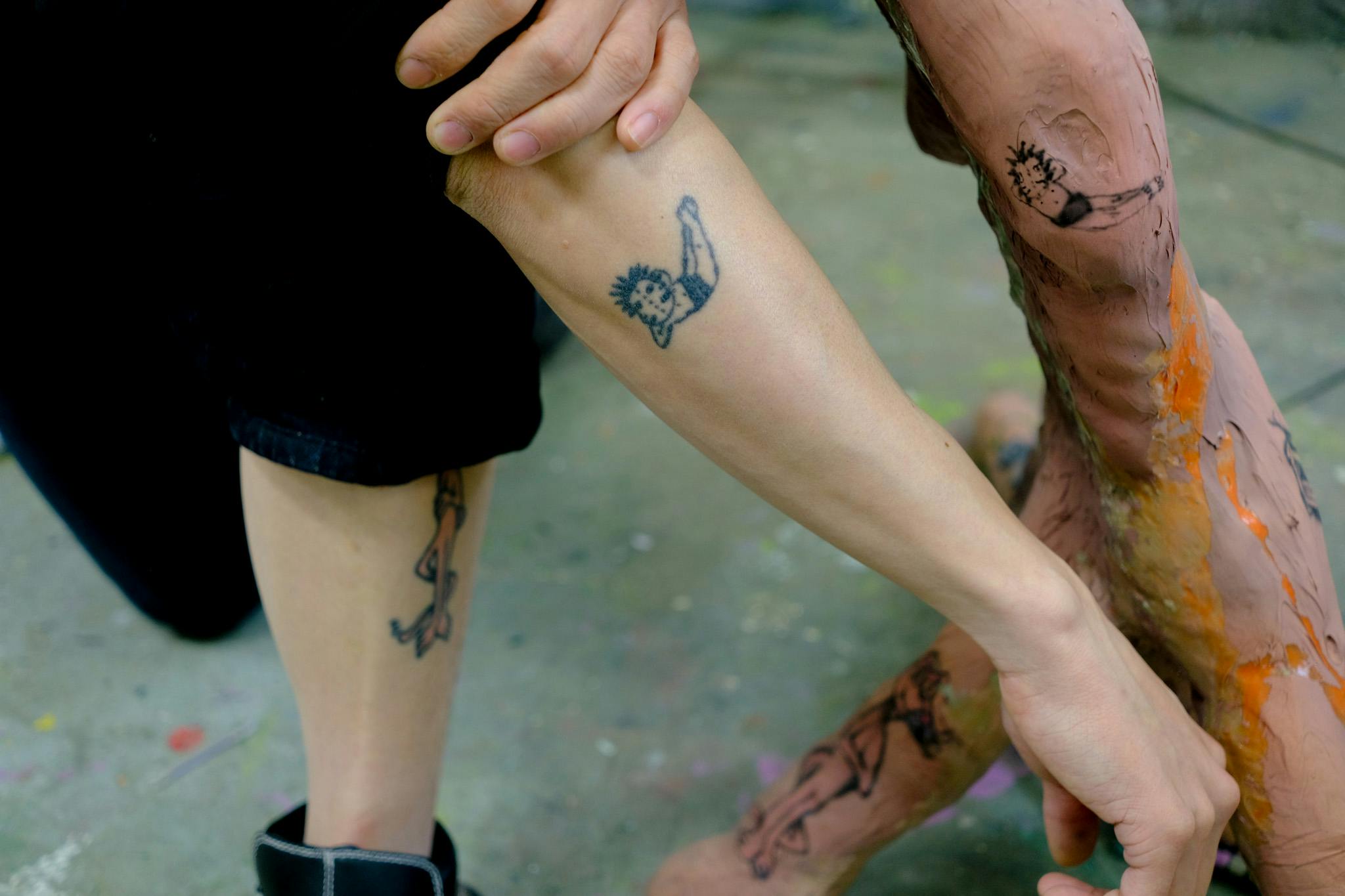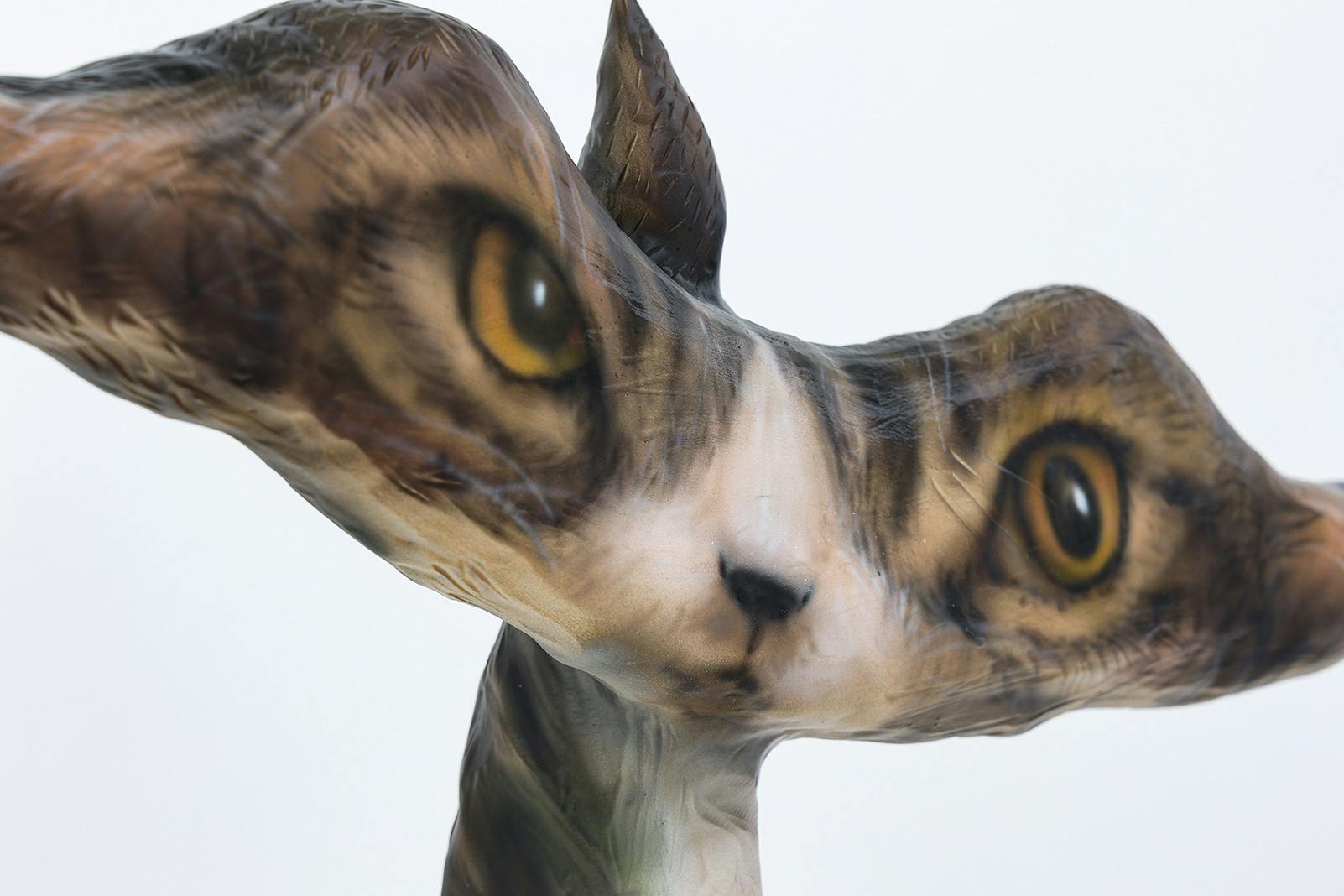
Studio Visit with Taewon Ahn
We do a studio visit in Seoul, South Korea, with painter Taewon Ahn
One evening, whilst indulging in some digital research for untapped functional artists, I stumbled upon a chair seemingly vacuum-wrapped with a digitised version of a tabby cat. Was it a chair? Was it a sculpture? Was it a render? I started digging deeper and found myself immersed in the imagination of Korean contemporary artist Taewon Ahn, where the lines between digital and analogue are entirely blurred and leave you with more questions than answers.
Inspired by his relationships with nonhuman species (ie:// Hiro the house cat) and the approach to befriending and understanding the social codes of animals informed the way that Taewon approaches his work as a painter. During my winter in Seoul, I was invited to pass by the studio he shares with several other artists, where we discussed his sensitivity to the behaviour and realities of all beings around him and the heavy influences of years entrenched in digital imagescapes and meme culture on his work.



The first piece of work of yours that I discovered was ‘HIRO IS EVERYWHERE,’ a collection of paintings and sculptures inspired by your cat Hiro. When you were a child, I read that you spent a lot of time with animals and sometimes even preferred their company to humans, which resonated with me as I was exactly the same. How has that connection inspired this breadth of work?
제가 처음 봤던 작가님의 작업은 고양이 히로에게서 영감을 받은 ‘HIRO IS EVERYWHERE’ 이었습니다. 작가님이 어렸을때 동물들이랑 놀면서 많은 시간을 보냈고 심지어는 사람이랑 노는 것보다 더 좋아하기도 했다고 말씀하신 것을 보았는데 저도 똑같은 경험이 있어서 공감이 되었습니다. 그런 것들이 어떻게 작업에 영향을 미쳤나요?
It was an interesting childhood experience to closely observe and relate to creatures who couldn't communicate with me and who looked so different. The process of building trust while simultaneously understanding animals' individual instincts and rules required patience, but it felt like a huge achievement to do so... and sometimes, I felt a certain accumulation of fatigue had built up within my relationships with people and these relationships with animals relieved that. I find that blending into an animal's territory, where a different set of rules apply, has a lot of similarities with painting actually. Both allow you to get away from reality and immerse yourself in an imaginative world. So, in a way, I feel like my relationships with animals have been a driving force behind my attitude towards my painting practice.
어린시절 의사소통이 안되고, 외형이 다른 생명체를 가까이서 지켜보고, 그들과 관계를 맺는 것은 흥미로운 경험이었습니다.
동물 개개의 본능과 규칙을 이해하고 다가가며 신뢰를 쌓아가는 과정은 인내심을 필요로 했지만 그만큼의 성취가 있었고 때로는 사람과의 관계에서 쌓인 피로가 해소되기도 했습니다. 인간 세상과 전혀 다른 규칙으로 돌아가는 그들의 영역에 녹아드는 것은 현실을 벗어나 상상의 세계로 빠져들게 만드는 그림의 영역과도 공통점을 띄고있습니다. 때문에 동물과의 관계는 그림을 그리는 태도에 있어 예나 지금이나 좋은 원동력이 됩니다.
How is Hiro doing? Does he know he is a muse?
히로는 잘 지내나요? 자기가 뮤즈인걸 알고 있나요?
Hiro is doing fine. He might need to go on a diet because he is becoming a fat cat. It doesn’t seem like he knows that he is a muse. One day, I showed him the piece when I had to bring the work home, but he didn’t show much interest. He would love to know that he’s a muse. But I’m giving him a lot of love.
히로는 잘 지내고 있습니다. 뚱뚱한 고양이가 되어가는 것 같아 다이어트를 시켜야 할 것 같습니다. 그리고 아무래도 히로는 자기가 뮤즈인 것을 모르는 듯 합니다. 언젠가 히로 조각을 집에 가지고 갈 일이 있어서 보여줬는데 별다른 관심을 보이지는 않았습니다. 뮤즈인 것을 알면 참 좋아할텐데요. 그래도 많은 애정을 주고 있습니다.


Your work also draws a lot of inspiration from Internet culture. Can you tell us a little bit more about that?
작가님의 작업은 인터넷 문화에서도 많이 영감을 받았다고 말씀해주셨는데 그것에 대해 조금 더 자세히 말씀해주실 수 있나요?
I was born in 1993 and raised when computers started to become popular in Korea. My father was a programmer, so I was able to access the digital world relatively early and at a younger age than most of my peers. I naturally became a person with a lot of digital sensitivity. Especially the cheerfulness of meme culture has influenced me a lot in my daily life. I love to joke around with friends, so I built a bond with them through sharing memes and consuming images. However, I eventually became tired during the process of finding rare and unpopular images and the constant stream of visual stimulation. Moreover, the fast consumption of highly volatile digital memes has made it difficult for me to focus or explore one singular subject, so I am trying to get out of it and be more grounded in a sense of physical reality.
저는 1993년생으로 대한민국에 컴퓨터가 보급화되던 시기에 나고 자랐습니다. 아버지의 직업이 프로그래머였던지라 또래에 비해 비교적 일찍 디지털 세상을 접할 수 있었고요. 시간이 지나 자연스레 디지털 감수성이 풍부한 인간이 되었습니다. 그중에서도 밈 문화가 가진 경쾌함과 위트는 현실의 일상에 적잖은 영향을 끼쳤습니다. 가뜩이나 저는 친구들과 농담따먹기를 좋아하는 사람으로 그들과 다양한 밈을 공유하며 공감대를 형성했고, 이미지를 소비했습니다.
그러나 점차 희소가치가 있는, 대중적이지 않은 이미지를 찾는 과정에서 자극적 이미지의 반복적인 노출로 인해 시각적인 피로감을 축적하게 되었습니다. 또한 휘발성이 짙은 디지털 밈의 빠른 소비패턴에 스스로 어떤 하나의 대상에 집중하기도, 탐구하기도 어려운 상황에 놓이게 되어 현재는 디지털 세상에서 벗어나 현실감각에 집중하려는 상태입니다.
Are there any specific aspects of the internet or contemporary culture which you are particularly fascinated with?
인터넷이나 동시대 문화에 작가님이 특별히 더 관심을 갖고 있는 부분은 무엇인가요?
At the moment, I have acknowledged how much influence digital media has on reality, and I am trying to take a step back to get a broader view. The reason for my obsession with working with one particular cat is similar to my struggle to get away from the digital chaos where the birth and death of images are repeated infinitely.
현재는 디지털미디어가 현실에 끼치는 많은 영향력을 인지하고 한발 물러서서 넓은 시야를 확보 하려고 합니다.
작업에 있어 현실의 고양이 한마리에 집착하는 이유도 이미지의 탄생과 죽음이 무한히 반복되는 디지털 세상의 아비규환에서 벗어나고자 하는 저의 몸부림 같은 것입니다. 그외 관심을 크게 두는 동시대 문화는 없습니다.


I read that you find difficulty in confronting your own emotions. Do you feel like virtual reality allows you to escape or explore emotions? How do you feel like your artistic practice reflects that?
작가님께서 스스로의 감정을 다루기 어려워 하신다는 것을 다른 인터뷰에서 읽었습니다. 가상세계가 이런 감정들을 다루는 것에 있어서 도움을 주나요? 또 그것이 어떤식으로 작업에 반영된다고 생각하시나요?
I am not sure in which context I said that I ‘find difficulty in confronting emotions’, but I guess I was talking about the situation when I am not honest with my own emotions. I tend to avoid depressing or sad feelings in regard to myself, which I realised from my friends’ observations. I think my obsession with the time and energy that I put into work pushes me to that state. Like, keep pushing myself, saying you can’t be tired or depressed. Fortunately, it doesn’t directly affect the work.
그 당시 어떠한 맥락으로 ‘감정을 다루기 어려워한다’는 말을 했는지는 잘 모르겠습니다. 추측한다면 아마도 저 스스로 감정에 솔직하지 못한 상태에 있는 것을 이야기한 것이 아닐까 합니다. 스스로 우울하거나 슬픈감정을 외면하는 경향이 있는데요. 이는 주변 친구들이 관찰한 저에 대한 이야기를 듣고 깨닫게 된 점입니다. 작업에 쏟는 시간과 에너지에 대한 집착이 스스로를 그러한 상태로 내몰게 되는 것 같아요. 계속 채찍질을 하는것입니다. 지치면 안되고 우울하면 안된다고. 다행히 그것이 작업에 직접적인 영향을 미치지는 않습니다.
You work with airbrush painting - how did you get into this medium and master it? What medium did you start with, and how did you get to airbrush?
에어브러쉬로 작업을 하신다고 하셨는데, 처음에는 어떤 도구로 시작하셨고 어떻게 에어브러쉬를 접하게 되어 익숙해지게 되셨나요?
I used to draw more than paint; I used mainly markers, pens and coloured pencils. When I was younger, I was impatient and had a narrower view, so I felt burdened to do big paintings, so I used mediums that were easier to express and get the effect that I wanted. I started to use airbrush after I accidentally came across Austin Lee’s painting while searching others' work on social media.
It wasn’t hard to get used to it because the characteristics of the airbrush match my personality. Airbrush is effective for making sense of volume quickly and can be mixed with many different materials for the texture, so you never get bored.


How do you feel this medium is the best one to express your ideas?
에어브러쉬가 작가님의 작업을 표현하기에 가장 적합하다고 생각하시나요?
Airbrush breaks down the paint into a fine mist, spraying it to create an image - like in the digital world, the small pixels combine together to become an image. I think it’s a good medium to express digital images in analogue reality and fits the context of my work.
Recently, I have been feeling like I am a sort of printer when I only work with airbrushes from 1 to 10. It forces the painter to be planned and rational. This made me crave finding a medium that I can physically struggle with a bit while painting, working with brushes that directly touch the canvas. So I am doing some experiments these days.
현재는 그렇습니다. 디지털 세상에서는 작은 픽셀들의 조합이 하나의 이미지가 되는 것처럼 에어브러쉬는 물감을 미세한 단위로 쪼개 분사하며 이미지를 만들도록 해줍니다. 아날로그 현실에 디지털의 이미지를 구현하는데 효과적이며 그렇기에 저의 작업 맥락과 맞아 떨어지는 좋은 재료라고 생각합니다.
여담으로 캔버스를 1에서부터 10까지 에어브러쉬로만 작업을 할 경우 마치 이미지를 인쇄하는 프린터기가 된 듯한 기분을 요즘 느끼고 있습니다. 그리는 사람으로 하여금 계획적이고 이성적이게 만들다보니 붓처럼 캔버스면과 직접적으로 닿으면서 그림과 씨름하게 만드는 매체에 대한 갈망이 최근에 생겼고 실험 중입니다.
You grew up very much inspired and immersed in Anime - how has that impacted your adult life and how you see the world?
애니메이션에서 많은 영향과 영감을 받으셨다고 하셨는데 구체적으로 애니메이션이 성인이 된 이후의 작가님의 생활과 세상을 바라보는 방식에 어떻게 영향을 미쳤나요?
There are no limits of imagination in the genre of Anime. I break the boredom of mundane thinking through cartoonistic corners of my imagination several times a day. Actually, a lot of times, it actually inspires work even though it starts off with light laughter and a fleeting image.
애니메이션이라는 장르는 상상력에 제한이 없습니다. 저는 하루에도 여러번 만화적 상상을 하며 일상의 지루함을 깹니다. 그것이 실제로 작업에 영감을 줄 때도 많습니다. 대부분 가벼운 실소를 유발하고 사라지는 정도이지만 말이죠.



I read that in South Korea, art can often be linked and grow in popularity when linked to consumer and retail collaborations, leading to other artists or brands copying the original idea. How do you feel about other artists copying or appropriating your work? How do you or would you respond to that happening?
한국에서는 미술이 상업적인 콜라보레이션 등을 통해 인기를 얻고 그것이 다른 작가들이나 브랜드의 카피로 이어지기도 한다고 들었습니다. 작가님의 아이디어가 카피되거나 유사하게 사용되는 것에 대해 어떻게 느끼시나요? 또 그런것에 어떻게 대응하실 것 같으신가요?
I have a dream of making Hiro the Cat into a king of the digital world, like some famous memes. Therefore, I applied the pattern of creation and ripple effect that memes have into reality and created the series “Hiro is Everywhere”. I wouldn’t be offended if someone copied my work in the same way that memes are completed by the numerous anonymous remakes which then spread. Of course, it really differs from case to case.
디지털 세상의 유명한 밈들처럼 저는 고양이 히로를 디지털 미디어 속 왕으로 만들고 싶다는 꿈을 가지고 있습니다. 때문에 밈의 형성방식, 파급효과를 유사하게 현실에 적용하여 연작한 시리즈가 ‘hiro is everywhere’ 입니다. 수많은 익명의 사람들이 달라붙어 재창작하고 퍼뜨렸을때 비로소 밈이 완성되는 것처럼 누군가에 의한 카피가 그렇게 기분이 나쁠 것같지는 않습니다. 물론 정도의 차이는 있겠지만요.
























